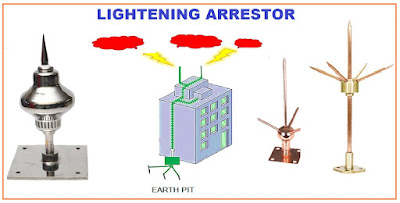Lightning Arresters | Types, Classes, and Voltage Protection Levels Explained for Effective Surge Protection
Lightning arresters also known as lightning surge arresters or simply surge arresters A lightning arrester is an electrical device used to protect buildings, structures, and electrical equipment from lightning strikes. It works by providing a path of low resistance for the lightning to follow, directing the electrical current safely to the ground.
During the rainy season, lightning strikes are more common due to the increased humidity in the air. Therefore, it is important to ensure that lightning arresters are properly installed and maintained to prevent damage to electrical systems and structures.
A lightning arrester works by providing a low-impedance path to ground for the lightning current, which bypasses the equipment to be protected. When a surge of voltage exceeds the normal voltage level, the lightning arrester conducts the surge to the ground. The arrester is designed to absorb the high voltage surge and dissipate it to the ground in a controlled manner, thereby protecting the connected equipment from damage.
There are two main types of lightning arresters:
Voltage-activated lightning arresters
These arresters are designed to activate when the voltage exceeds a certain threshold level. They work by using a spark gap, which conducts the surge to ground when the voltage exceeds a certain level.
Current-activated lightning arresters
These arresters are designed to activate when the current exceeds a certain threshold level. They work by using a metal oxide varistor (MOV), which provides a low-impedance path to ground when the current exceeds a certain level.
Lightning arresters are typically used in high-voltage power transmission and distribution systems, as well as in telecommunications and other sensitive electronic equipment. They are an essential component in protecting equipment from damage due to lightning strikes and other transient voltage surges.
Lightning Arresters Classification
Lightning arresters are classified according to the level of protection they provide against lightning surges. The International Electrotechnical Commission (IEC) has developed a standard known as IEC 61643-11, which specifies the requirements and test methods for lightning surge protective devices. The protection class of a lightning arrester is based on the maximum surge current it can handle, and is typically indicated by a number or letter code. Here are the common protection classes for lightning arresters:
Class I: These lightning arresters are designed to protect against direct lightning strikes to a building or structure. They can handle high current surges of up to 100 kA or more and are typically installed at the main electrical service entrance.
Class II: These lightning arresters are designed to protect against indirect lightning strikes or surges from the power grid. They can handle moderate current surges of up to 40 kA and are typically installed at the distribution panels or subpanels.
Class III: These lightning arresters are designed to protect against surges from equipment within a building or structure. They can handle lower current surges of up to 10 kA and are typically installed at the point of use, such as at the equipment or device being protected.
Additionally, some lightning arresters are classified by their voltage protection level (VPL), which indicates the maximum voltage the arrester can withstand without failing. The VPL is typically expressed as a value in kilovolts (kV).
It's important to note that the appropriate protection class for a lightning arrester depends on the specific application and the level of risk






Post a Comment